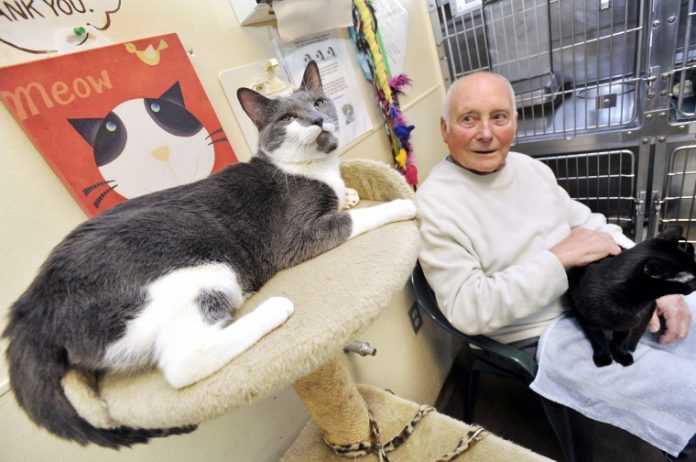
Pulling soiled towels from a hamper and loading them by the armfuls into a washing machine, kennel attendant Lavonne Gonzales with the Santa Clara County Animal Shelter contemplated the joys of caring for hundreds of animals that live, eat, play and poop under the same roof.
With a washer and dryer hook-up capable of powering half of the 10 daily laundry loads generated by a facility that takes in more than 3,000 animals a year, shelter volunteers are frequently forced “to go to the Laundromat and load poopy blankets,” chuckled Gonzales.
“Remember that one time at the Laundromat when the (poop) fell out of the towel and onto the floor?” said Shelter Supervisor Brigid Wasson, making light of her occupation’s unappetizing hazards.
“Yeah, you gotta shake it before you put it in the wash,” advised Gonzales.
Built in the early ’70s and located at 12370 Murphy Ave. in San Martin, the Santa Clara County Animal Shelter is something of a terrestrial Noah’s Ark that caters not only dogs and cats, but also to abandoned horses, geese, ducks, peacocks, sheep and goats.
With an overall adoption and reclaim rate of 80 percent in 2011 (the national average is slightly more than 50 percent), the organization managed to place 100 percent of the healthy animals that came through its doors last year.
Albeit, the 40-year-old facility is plagued by slew of structural deficiencies.
With a “hodgepodge” ventilation system, “jailhouse-style” cat cages, limited parking, a surgery room that feels like a walk-in closet and old drains that sometimes clog and regurgitate refuse, the time has come for an extreme shelter makeover.
“We do a good job with what we have, but it’s a challenge,” said Wasson, vanishing into a dark employee break room that has the ambiance of a stuffy catacomb.
Inside, flies hover overhead. A small metal grate in the cement floor leads to the same common drainage system that collects excrement from all the kennels.
“It’s disgusting,” said Wasson, pointing to a mousetrap sitting in plain site next to the base of the refrigerator. “Having a better staff area to take a break would boost morale. Is this where you would want to eat your lunch?”
Alas, a glimmer of encouragement is twinkling on the horizon for the shelter fueled by 50 volunteers and servicing 3,200 dogs, cats and other furry houseguests annually.
Last year, the Santa Clara County Board of Supervisors authorized a Capital Building Campaign that will jumpstart the process of erecting a new regional shelter for South County. The initial phases entail establishing a nonprofit that could accept donations for a new shelter facility, outlining a fundraising plan and conducting a programming study that will ascertain the needs of the new shelter.
When the study is finalized in November, the next steps will be to organize a financial timeline, spearhead a fundraising campaign and begin the process of drawing up design plans, for which the county has designated $461,000.
As for location, the leading contender is the site of the former County Courthouse on the corner of Highland Avenue and Monterey Highway in San Martin.
Kevin O’Day, Santa Clara County Agricultural Commissioner, doesn’t have concrete figures of what the new shelter will cost, but estimates $12 to $20 million will have to be generated through aggressive fundraising and private donations. He said the current net cost for operating the San Martin shelter is about $2 million annually.
So far, county officials have already visited Humane Societies and various shelters throughout the South Bay and Silicon Valley to collect advice, reap inspiration and cherry pick their favorite ideas.
“Whenever there is a project of this magnitude, it’s wonderful to have people who can share in their experience of what went well and what didn’t work for them,” said Day.
With animal welfare and a pleasant customer experience being the overarching end goals, a plethora of possibilities for the new shelter are on the table for consideration.
Day lists a handful of ideas, such as pet daycare; a multipurpose room that can be used for volunteer training or to conduct classes for new pet owners; an in-house coffee shop and/or pet store, bigger outdoor recreation areas for exercising and walking dogs/horses; a built-in dog park, beefed-up livestock accommodations and a state-of-the-art clinic equipped to handle complex animal medical and behavioral conditions. The San Martin shelter currently cannot cater to spay/neuter services for the public, and must contract with 14 area vet clinics to accommodate its in-house population.
While giving a tour last month, Wasson exhibited a positive attitude about working with what she’s got. She doesn’t sugarcoat the situation, however.
The feline room, which can house up to 50 occupants, has a poor HVAC system. Wasson likens it to having “50 cats in the equivalent of an airplane cabin.”
The same goes for the cat quarantine area: The shelter needs better ones, and more of them.
“It’s like everybody in the hospital being in the same room,” she says.
The dog kennels, which are not air conditioned, can be stifling in 105-degree summer weather (even with portable fans). With the capacity to accommodate 60 canines, the chain-link enclosures are noisy, hard to sleep in and stressful for timid dogs who get bullied by bunkmates over food.
In the new shelter, Wasson wants Plexiglas cages with individual drains instead of a common gutter system.
That way, volunteers won’t have to spray excrement out of the cages and towards the visitor’s walkway.
“It’s time for a new shelter,” Day concluded. “Let’s start taking the first steps down that new path.”







